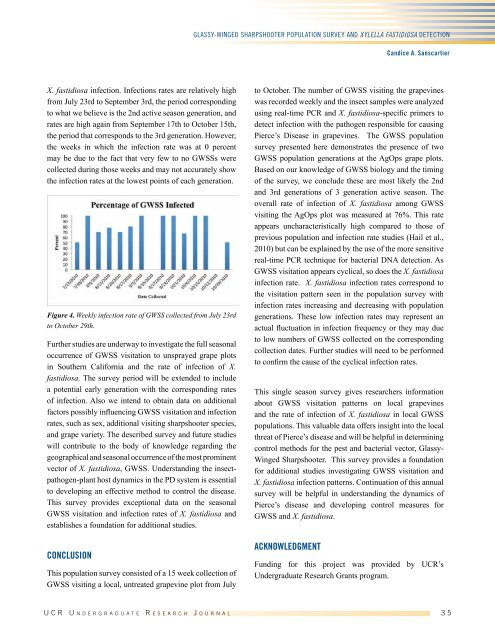Undergraduate Research Journal
Undergraduate Research Journal
Undergraduate Research Journal
You also want an ePaper? Increase the reach of your titles
YUMPU automatically turns print PDFs into web optimized ePapers that Google loves.
Glassy-Winged Sharpshooter Population Survey and Xylella fastidiosa Detection<br />
Candice A. Sanscartier<br />
X. fastidiosa infection. Infections rates are relatively high<br />
from July 23rd to September 3rd, the period corresponding<br />
to what we believe is the 2nd active season generation, and<br />
rates are high again from September 17th to October 15th,<br />
the period that corresponds to the 3rd generation. However,<br />
the weeks in which the infection rate was at 0 percent<br />
may be due to the fact that very few to no GWSSs were<br />
collected during those weeks and may not accurately show<br />
the infection rates at the lowest points of each generation.<br />
Figure 4. Weekly infection rate of GWSS collected from July 23rd<br />
to October 29th.<br />
Further studies are underway to investigate the full seasonal<br />
occurrence of GWSS visitation to unsprayed grape plots<br />
in Southern California and the rate of infection of X.<br />
fastidiosa. The survey period will be extended to include<br />
a potential early generation with the corresponding rates<br />
of infection. Also we intend to obtain data on additional<br />
factors possibly influencing GWSS visitation and infection<br />
rates, such as sex, additional visiting sharpshooter species,<br />
and grape variety. The described survey and future studies<br />
will contribute to the body of knowledge regarding the<br />
geographical and seasonal occurrence of the most prominent<br />
vector of X. fastidiosa, GWSS. Understanding the insectpathogen-plant<br />
host dynamics in the PD system is essential<br />
to developing an effective method to control the disease.<br />
This survey provides exceptional data on the seasonal<br />
GWSS visitation and infection rates of X. fastidiosa and<br />
establishes a foundation for additional studies.<br />
CONCLUSION<br />
This population survey consisted of a 15 week collection of<br />
GWSS visiting a local, untreated grapevine plot from July<br />
to October. The number of GWSS visiting the grapevines<br />
was recorded weekly and the insect samples were analyzed<br />
using real-time PCR and X. fastidiosa-specific primers to<br />
detect infection with the pathogen responsible for causing<br />
Pierce’s Disease in grapevines. The GWSS population<br />
survey presented here demonstrates the presence of two<br />
GWSS population generations at the AgOps grape plots.<br />
Based on our knowledge of GWSS biology and the timing<br />
of the survey, we conclude these are most likely the 2nd<br />
and 3rd generations of 3 generation active season. The<br />
overall rate of infection of X. fastidiosa among GWSS<br />
visiting the AgOps plot was measured at 76%. This rate<br />
appears uncharacteristically high compared to those of<br />
previous population and infection rate studies (Hail et al.,<br />
2010) but can be explained by the use of the more sensitive<br />
real-time PCR technique for bacterial DNA detection. As<br />
GWSS visitation appears cyclical, so does the X. fastidiosa<br />
infection rate. X. fastidiosa infection rates correspond to<br />
the visitation pattern seen in the population survey with<br />
infection rates increasing and decreasing with population<br />
generations. These low infection rates may represent an<br />
actual fluctuation in infection frequency or they may due<br />
to low numbers of GWSS collected on the corresponding<br />
collection dates. Further studies will need to be performed<br />
to confirm the cause of the cyclical infection rates.<br />
This single season survey gives researchers information<br />
about GWSS visitation patterns on local grapevines<br />
and the rate of infection of X. fastidiosa in local GWSS<br />
populations. This valuable data offers insight into the local<br />
threat of Pierce’s disease and will be helpful in determining<br />
control methods for the pest and bacterial vector, Glassy-<br />
Winged Sharpshooter. This survey provides a foundation<br />
for additional studies investigating GWSS visitation and<br />
X. fastidiosa infection patterns. Continuation of this annual<br />
survey will be helpful in understanding the dynamics of<br />
Pierce’s disease and developing control measures for<br />
GWSS and X. fastidiosa.<br />
ACKNOWLEDGMENT<br />
Funding for this project was provided by UCR’s<br />
<strong>Undergraduate</strong> <strong>Research</strong> Grants program.<br />
U C R U n d e r g r a d u a t e R e s e a r c h J o u r n a l 3 5














